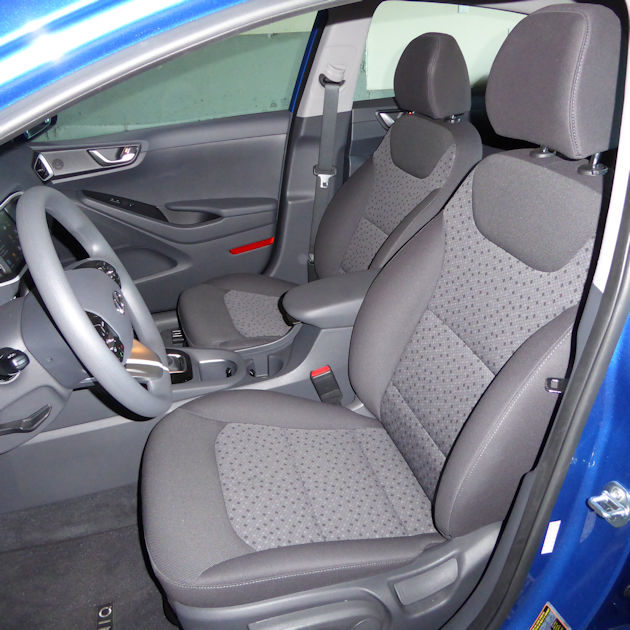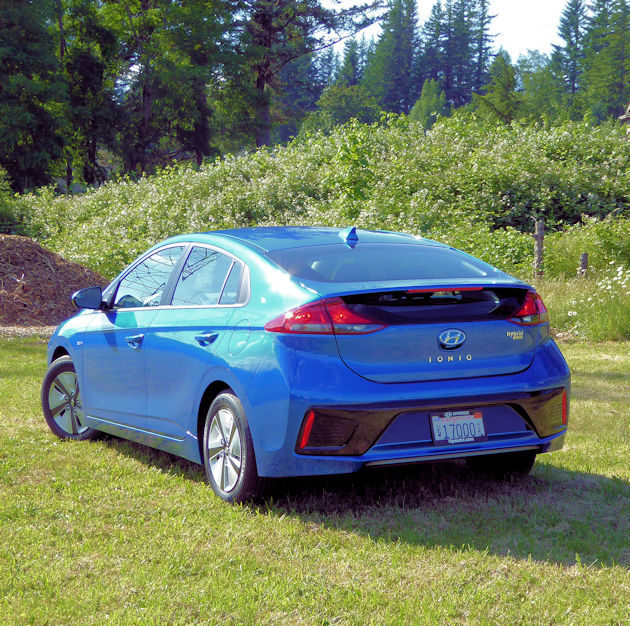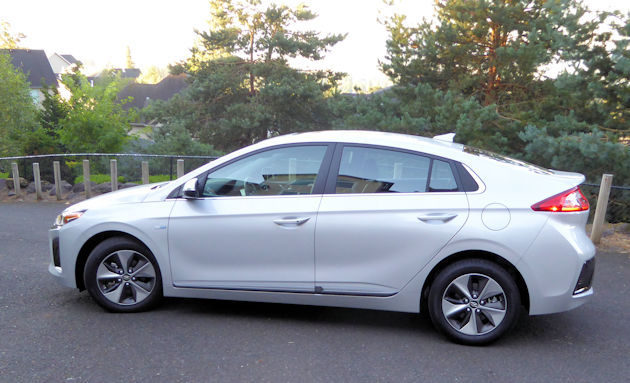By Barbara & Bill Schaffer
If imitation is the sincerest form of flattery, it seems Hyundai took a page out of Toyota?s playbook to build the Ioniq. It is the same size, looks similar and has the basic elements to the bestselling hybrid of all time, the Toyota Prius.
Hyundai engineers were also off to a running start when they designed the Ioniq, by using the company?s best-selling mid-size car, the Elantra, as a basis for the new electrified models.

Rather than using the Elantra sedan layout, the designers made the Ioniq a more convenient five-door hatchback configuration and gave it a full wind tunnel treatment, bringing the aerodynamics down to a class-leading 0.24 Cd. Unlike some hybrids and electric vehicles, which have integrated what we think are strange design elements like bug eye headlight pods or weird tail light treatments, the Ioniq has a more traditional styling.

It has the Hyundai family design elements, including the large trapezoidal grille, the sculpted sides and nicely tailored rear end. The rear hatchback even has a glass section designed to improve rear visibility. We think it?s a very good-looking car ? maybe not quite a head-turner, but close.

Interior elements are like the Elantra, but with their own flare and an eye toward ease of use with abundant redundant controls on the face of the steering wheel, a large high-mounted infotainment screen and conventional control buttons.

What sets the Ioniq apart from most competitors, however, is the availability of three distinct propulsion systems. The least expensive, and likely the best seller, is the Hybrid Blue. With a price starting at $23,085, including the destination charge, the Ioniq Hybrid Blue is a bargain. The well-equipped base model boasts and EPA fuel economy rating of 57 mpg city, 59 mpg highway and 58 mpg combined and those numbers are significantly higher than the Prius. We averaged 55.1 mpg during a week behind the wheel.

The hybrid is available two other trim levels with top model, the Limited, priced at $28,335. Fully loaded, the Limited has features like Smart Cruise Control, Lane Departure Warning, active headlights, navigation, leather seating and all the features and conveniences we?ve come to expect on a top-level model. With all the available options, the price peaks at $31,385.
Fuel economy numbers and pricing has not been announced for the Plug-In Hybrid, which is due in the Fall of 2017.

Both the Hybrid and Plug-In Hybrid are powered by a 104-hp 1.6-liter direct-injected Atkinson-cycle four-cylinder engine and attached to a very smooth shifting six-speed double-clutch transmission, which we much prefer to the continuously variable transmission used by most competitors. The transmission imparts a more positive feel and allows the driver to downshift as needed for better control. Acceleration is slow making a 0 to 60 mph run in 9.4 seconds.

The Hybrid engine is assisted by a 43-hp (32-kWh) electric motor which when combined with the gasoline engine produces a total output of 139 hp. The Hybrid?s electric motor draws its power from a 1.56-kWh lithium-ion polymer battery, mounted under the rear passenger seat.

When it arrives in the fall, the Plug-In Hybrid will have a 60-hp (45-kW) electric motor powered by an 8.9-kWh lithium-ion polymer battery. It?s expected have an all-electric range of more than 25 miles.

And then there is something completely different, the Hyundai Ioniq Electric. Under the hood there is a 120-hp (88 kWh) with a 28-kWh lithium-ion polymer battery. Having driven may electric cars the last few years, our first thought is how far can we go ? or we had the pre-jitters of ?Range Anxiety?. The gauge on the instrument panel indicates the same as the press materials ? 124 miles. We were easily able to get a full charge overnight using our 120v garage outlet. Plus, in our area there are fast public charging stations to do the same job while you?re in shopping or dining.

Driving other electric vehicles, we?ve often noticed a disparity between what the gauge says and the actual distance we drive. We live at the top of a long, steep hill, and normally going down adds a mile or two to the range, and sometimes going up will take four or five miles off the range. The Ioniq electric stayed relatively true to the actual distance traveled and we didn?t seem to be playing that electric car driver game of trying to save range or minimize range loss.
We found the Electric to be very quiet, with no noticeably electric car whine. It didn?t seem to be quite as peppy as some electric cars, but it is probably the smoothest we?ve driven. Buff magazine tests show a 0 to 60 mph acceleration time of 8.0 seconds.

We liked the steering wheel mounted shift paddles which allow the driver to change the level of regenerative charging. Pull the left paddle and it tightens up and brakes the car, and in the process, increases the charging. Pull the right paddle and the car seems to loosen up and runs less constricted. The paddles moved from 0 to 4 on the indicator light on the instrument panel to show the driver the exact level of braking force set. We used it for downshifting for corners on winding roads.
Hybrid models use a MacPherson strut front suspension and an independent multi-link setup in the rear. The Ioniq Electric uses the same front, but the rear has a torsion beam rear axle which allows more space for the larger battery.

Unfortunately, the Hyundai Ioniq Electric is only available in California now. It is available in three trim levels: Base, Limited and Limited Ultimate. The Ioniq is available with a unique Ionic Unlimited+ Subscription Program which covers all cost in the monthly payment including Unlimited Mileage, Charging Reimbursement, Complimentary Maintenance and Wear Items and Initial Taxes, Title, License, and Fees. The Three models have a program price of $275, $305, and $365 per month respectively. For more information go to your California Hyundai dealer or check online at https://www.hyundaiusa.com/ioniq-electric/index.aspx .
Hyundai appears to have found another winning combination with the Ioniq. It looks good, feels solid, the fuel economy numbers are outstanding, and the prices are great. Plus, it?s got the same outstanding Hyundai Assurance program, which includes a 5-year/60,000-mile fully-transferable new vehicle limited warranty, Hyundai?s 10-year/100,000-mile powertrain limited warranty and five years of complimentary Roadside Assistance. How can you go wrong?









